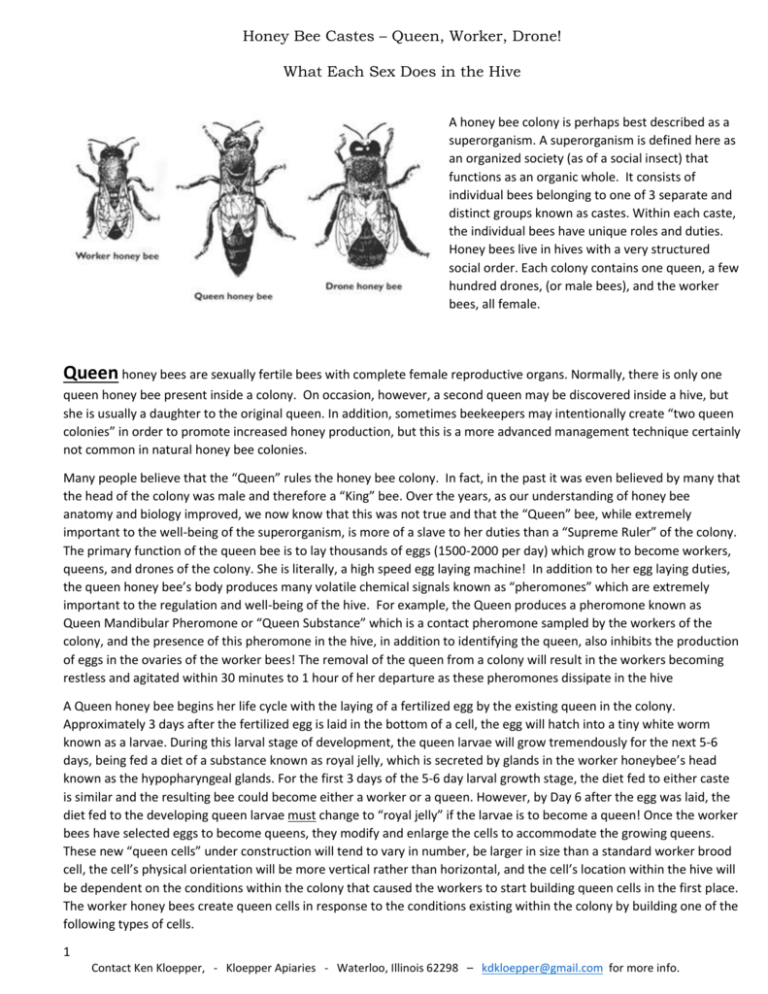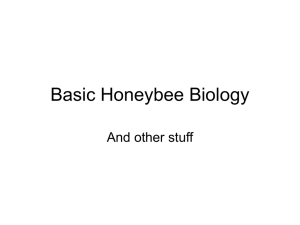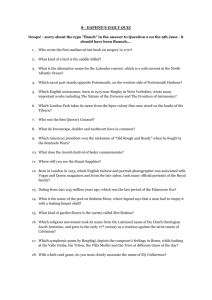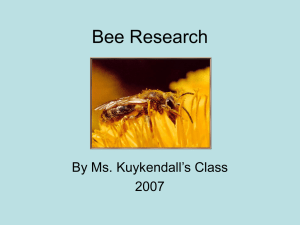Honey Bee Castes * Queen, Worker, Drone!
advertisement

Honey Bee Castes – Queen, Worker, Drone! What Each Sex Does in the Hive A honey bee colony is perhaps best described as a superorganism. A superorganism is defined here as an organized society (as of a social insect) that functions as an organic whole. It consists of individual bees belonging to one of 3 separate and distinct groups known as castes. Within each caste, the individual bees have unique roles and duties. Honey bees live in hives with a very structured social order. Each colony contains one queen, a few hundred drones, (or male bees), and the worker bees, all female. Queen honey bees are sexually fertile bees with complete female reproductive organs. Normally, there is only one queen honey bee present inside a colony. On occasion, however, a second queen may be discovered inside a hive, but she is usually a daughter to the original queen. In addition, sometimes beekeepers may intentionally create “two queen colonies” in order to promote increased honey production, but this is a more advanced management technique certainly not common in natural honey bee colonies. Many people believe that the “Queen” rules the honey bee colony. In fact, in the past it was even believed by many that the head of the colony was male and therefore a “King” bee. Over the years, as our understanding of honey bee anatomy and biology improved, we now know that this was not true and that the “Queen” bee, while extremely important to the well-being of the superorganism, is more of a slave to her duties than a “Supreme Ruler” of the colony. The primary function of the queen bee is to lay thousands of eggs (1500-2000 per day) which grow to become workers, queens, and drones of the colony. She is literally, a high speed egg laying machine! In addition to her egg laying duties, the queen honey bee’s body produces many volatile chemical signals known as “pheromones” which are extremely important to the regulation and well-being of the hive. For example, the Queen produces a pheromone known as Queen Mandibular Pheromone or “Queen Substance” which is a contact pheromone sampled by the workers of the colony, and the presence of this pheromone in the hive, in addition to identifying the queen, also inhibits the production of eggs in the ovaries of the worker bees! The removal of the queen from a colony will result in the workers becoming restless and agitated within 30 minutes to 1 hour of her departure as these pheromones dissipate in the hive A Queen honey bee begins her life cycle with the laying of a fertilized egg by the existing queen in the colony. Approximately 3 days after the fertilized egg is laid in the bottom of a cell, the egg will hatch into a tiny white worm known as a larvae. During this larval stage of development, the queen larvae will grow tremendously for the next 5-6 days, being fed a diet of a substance known as royal jelly, which is secreted by glands in the worker honeybee’s head known as the hypopharyngeal glands. For the first 3 days of the 5-6 day larval growth stage, the diet fed to either caste is similar and the resulting bee could become either a worker or a queen. However, by Day 6 after the egg was laid, the diet fed to the developing queen larvae must change to “royal jelly” if the larvae is to become a queen! Once the worker bees have selected eggs to become queens, they modify and enlarge the cells to accommodate the growing queens. These new “queen cells” under construction will tend to vary in number, be larger in size than a standard worker brood cell, the cell’s physical orientation will be more vertical rather than horizontal, and the cell’s location within the hive will be dependent on the conditions within the colony that caused the workers to start building queen cells in the first place. The worker honey bees create queen cells in response to the conditions existing within the colony by building one of the following types of cells. 1 Contact Ken Kloepper, - Kloepper Apiaries - Waterloo, Illinois 62298 – kdkloepper@gmail.com for more info. Honey Bee Castes – Queen, Worker, Drone! What Each Sex Does in the Hive Emergency Cells - (Built generally in response to an unexpected departure or death of the queen). Supersedure Cells - (Built generally in response to an unacceptable, poorly performing, or aging queen). Swarm Cells – (Built generally in response to a natural desire to reproduce, or to hot, overcrowded conditions existing within the colony). 2 Contact Ken Kloepper, - Kloepper Apiaries - Waterloo, Illinois 62298 – kdkloepper@gmail.com for more info. Honey Bee Castes – Queen, Worker, Drone! What Each Sex Does in the Hive The highly nutritious royal jelly produced in the hypopharyngeal glands of the worker bees changes in composition, and this “royal jelly” as compared to normal “worker jelly” causes physiological changes which result in the larvae developing into a queen. Larvae not receiving the royal jelly by Day 6 are destined to develop into a worker bee, or more infrequently into a useless mutated bee known as an “intercaste” queen. Assuming that the rich royal jelly diet is provided to the queen by Day 6, she should continue to develop into a normal queen. The earlier in the queen’s larval stage that she begins to receive the high quality royal jelly, the larger her ovarioles will grow, and the more eggs she will be capable of laying in her lifetime, therefore, generally the better the quality of the queen. On approximately Day 7 to 9 after the egg was laid, the queen cell will be capped with a thin layer of beeswax. The queen “pupa” as she is known at this stage will grow at a faster rate than a worker, completing her pupal stage development and emerging from the queen cell as an adult virgin queen on or about Day 16. The instinct of this newly emerged queen is such that she will soon look to remove any possible competition from other virgin queens that may have emerged. She will quickly seek out the unhatched queen cells, generally tearing the sides of the cells out. Using her stinger, she kills the yet unhatched virgin queens! Should several virgin queens emerge at the same time, they will fight to their death, until only one virgin queen survives. This newly hatched virgin queen now matures quickly, and in only about 4 to 5 days after she hatches, she will start taking short orientation flights outside the hive to learn the colony’s location. At approximately 7-10 days of age she will start searching for areas located perhaps one-half mile to 5 miles away from her colony containing mature drones to mate with, in order to minimize the likelihood of inbreeding. These areas are known as DCA’s or Drone Congregation Areas. The young, virgin queen flies around these DCA’s, attempting to attract the attention of the drones. Once accomplished, she flies upward leading a group of potential mates, until only the quickest and strongest drone succeeds in mating in flight with the queen. A virgin queen will typically fly from the hive over a 3 or 4 day period, mating with an average of 12-15 different drones. After each mating in flight, the drone having successfully mated with the queen, immediately falls to his death. The semen from these “successful” drones is stored in an organ in the queen’s body known as a “spermatheca”, and is used to fertilize the queen’s eggs for the remainder of her life. After her mating flights are completed, the queen now returns to her colony, unlikely to ever mate again. Virgin queens that do not mate by 3 to 4 weeks of age, are unlikely to ever mate, and will most likely become known as a “drone laying queen” since she is unable to lay fertilized eggs. After a couple of days of hormonal changes following her mating flights, the newly mated queen will begin laying all of the eggs the colony will need to survive. A typical queen can lay eggs and live up to 3 or 4 years, but in most cases, will swarm out of the hive with, or be superseded by, the colony workers after only a year or two. As mentioned above, the queen honey bee’s primary role in the superorganism is to provide all the eggs the colony will require. The mated queen begins the egg laying process by first inspecting each cell to assure that it has been cleaned and prepared by the worker honey bees to receive the queen’s egg. The queen, then using her forelegs to measure the cell, determines what type of egg to lay in the cell, (fertilized or unfertilized). Worker cells, (visibly smaller across than drone cells) will be selected by the queen to lay a fertilized egg in, which will develop only into a worker or queen. For the larger diameter cells, the queen will lay an unfertilized egg which can only develop into a drone. Honey bees reproduce by either a fertilized diploid system (2 sets of 16 chromosomes for a total of 32 chromosomes in the case of workers and queens) or in the case of drones, an unfertilized haploid system (1 set of 16 chromosomes from the queen only) of reproduction exists. In simpler terms, a male (drone) honey bee has no father! Sex determination in honey bees is actually determined by a single gene known as the complimentary sex determiner (CSD) gene. 3 Contact Ken Kloepper, - Kloepper Apiaries - Waterloo, Illinois 62298 – kdkloepper@gmail.com for more info. Honey Bee Castes – Queen, Worker, Drone! What Each Sex Does in the Hive Worker honey bees are infertile female bees that make up the vast majority of the population within a honey bee colony. They number anywhere from a few hundred individuals up to as many as 60,000 workers, (midsummer), in a single colony. Their role in the function of the superorganism is perhaps the most varied and complex of the 3 castes of bees. Worker bees, as their name implies, do the work of the colony. Under normal colony conditions, workers do not lay eggs. They are, however, actively involved with the nourishment and care of the hive’s thousands of eggs and larvae, collectively known as the “brood” within the colony. It is this brood that will grow into many thousands of adult honey bees. Worker bees live 5 to 6 weeks during most of the calendar year, with those adult workers that hatch in the fall living up to 6 months, which allows a new generation of worker bees to develop in the spring before they die. The differences in the length of an individual worker bee’s life is not fully understood, but depends upon their diet, the functions and activities of various hormones and glands, and chemical signals known as pheromones. A worker honey bee also begins it’s life cycle with the laying of a fertilized egg by the queen. Approximately 3 days after the fertilized egg is laid by the queen in the bottom of a cell, the egg will hatch into a tiny white worm known as a larvae. During this stage of development of the worker honey bee, the larvae will again grow tremendously for the next 5-6 days, being fed a diet of royal jelly (or perhaps more acurately, worker jelly), which is secreted by glands in the honeybee’s head known as the hypopharyngeal glands. On approximately day 8 to 9 after the egg was laid, the larvae will nearly fill the bottom of the cell and then extend itself lengthwise in the cell in preparation for the closing of the cell with a thin layer of beeswax known as the capping. Once capped with wax, this growing worker bee is also known as a “pupa”. It is during this stage of development that the worker pupa spins it’s cocoon, and transforms into an adult worker bee, thereby completing the process known as “metamorphosis”. On approximately Day 20 to 21 after the fertilized egg was laid, the new “adult” worker honey bee hatches by chewing through the wax capping and releasing itself from the cell. As each worker ages, their individual work roles and duties change according to a process known as the “Division of Labor”. Upon her release from the cell, the new worker bee takes on the duties of a housekeeper, by cleaning the cells of combs within the brood chamber. Next, she begins to feed the older larvae, honey and pollen. After a few days, the worker bee’s hypopharyngeal glands have matured enough that she will secrete the highly nutrious substance known as royal jelly which she feeds to the larvae as she takes on the important role of “nurse” bee, tending to the needs of the brood as well as the queen. At about 2 to 3 weeks of age, the worker begins food handling and comb building duties within the hive. At approximately 3 weeks of age, the worker first ventures outside the colony, first attending to tasks such as guarding the hive and ventilation, before starting to fly out on the first foraging flights. These foraging flights continue throughout the remaining 2 to 3 weeks of her 6 week lifespan, as the worker seeks out sources of nectar, pollen, water, and a substance known as propolis to supply the needs of the growing superorganism. Worker honey bees forage for nectar, (the sugary secretions of plants and flowers) in order to supply the colony’s needs for carbohydrates in their diet. The nectar is collected by the worker honey bees by sucking it in through their proboscis (mouth parts) and delivering it to the crop (honey stomach), where it is mixed with enzymes such as invertase in order to invert the complex sugar into simpler sugars, such as glucose and fructose. The mixture is then passed back up from the honey stomach through a process known as trophallaxis to another house bee which repeats the process. After several cycles, a worker bee will place the liquid into the cells of honey comb for ripening. The bees will ripen the honey by passing air over the cells and removing moisture until the honey reaches approximately 18% moisture content. At this point, a thin layer of beeswax known as the cappings are placed over the cell sealing the honey inside and preventing fermentation. Pollen collection is also necessary to provide the protein necessary in the honey bees diet. Workers in the process of gathering pollen, provide an often overlooked and under appreciated service known as “pollination”. As the honey bee forages to fill the corbiculae (pollen baskets on her rear legs), she is also making it possible for plants to produce fruit and vegetables for us to eat, a service many times more valuable than all of the honey and beeswax a 4 Contact Ken Kloepper, - Kloepper Apiaries - Waterloo, Illinois 62298 – kdkloepper@gmail.com for more info. Honey Bee Castes – Queen, Worker, Drone! What Each Sex Does in the Hive beehive can produce. Another important duty of young worker bees is comb building. The worker bee has 4 pairs of wax glands along the underside of its abdomen which secrete irregular shaped flakes or scales of wax, which the worker then removes and passes to her mandibles to manipulate just prior to affixing it in the construction of honeycomb. This process of wax production requires the bees to comsume large quantities of honey and pollen. Studies by Whitcomb (1946) indicated that approximately 8 lbs of honey is consumed to produce a single lb. of beeswax. Drone honey bees are fertile male bees. The important role and only job of the drone is to mate with the queen honey bee. The drone’s life cycle starts when the queen lays an unfertilized egg in a visibly larger diameter cell. The unfertilized egg hatches into a tiny larvae 3-5 days later. The drone larvae grows rapidly and is capped on or about Day 10 after the egg was laid. The drone pupa spends the next 14 days under the cell capping before emerging as an adult drone honey bee on Day 24. Upon emergence from the cell, the drone spends up to 6 days within the colony before making their first flights out of the hive. The young drones need time to sexually mature before mating with a virgin queen. They will most often fly short distances (< 0.3 miles) and close to the ground in drone flyways for the first 8 to 10 days after they hatched. As they mature, they fly higher and further from the hive (average 1.5 to 2.0 miles) to reach the drone congregation areas where they will attempt to mate with a queen. The drone is attracted by pheromones produced by the queen and once in the area of a queen, uses his large eyes to orient to the queen. Multiple drones attracted by a virgin queen will form a drone comet as they follow the pheromone scent of the queen. Most drones delay mating attempts until they reach maturity somewhere around 12-18 days of age. As the drones age, they take longer and longer mating flights from the hive sometimes exceeding 3 hours. Young drones are usually fed by nurse bees but after a while, they feed themselves both honey and pollen as it requires a lot of energy to stay aloft during the mating flights. Drones are produced in their greatest numbers in early spring as the bees recognize the need for the drones to mate with virgin queens. As the season progresses, the number of drone eggs laid by the queen will diminish. The drones are mostly tolerated by the workers during the summer, as they may still be needed to mate with a queen. However, as autumn approaches, and the worker bees become more defensive of their winter stores of honey, the drones are treated as expendable and prevented from reentering the hive. This usually occurs somewhere around late October and the drones will die from exposure in front of the hives. Only occasionally, will a drone be found inside a colony during the winter months. This special frame (Note larger cell size) of drone brood showing the convex (bullet shaped) drone cells. Frames like this can be utilized in early spring for drone production in order to saturate local DCA’s with lots of mature drones for mating. Another common use is for a varroa mite control method known as “drone trapping”. 5 Contact Ken Kloepper, - Kloepper Apiaries - Waterloo, Illinois 62298 – kdkloepper@gmail.com for more info.








